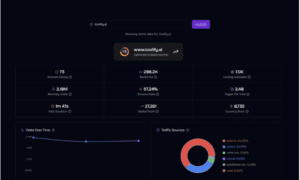As a startup founder, you’re juggling growth, product, hiring, customer feedback, investor updates – and let’s be honest, probably your coffee machine too.
Amid all the chaos, one of the smartest moves you can make is adopting OKRs to keep your team aligned, focused, and accountable.
But here’s the thing: you need OKR software that works for you, not something that adds more complexity or pulls your team into endless setup and training loops.
So, we’ve rounded up the 7 best OKR software platforms for startups in 2025 – tools that are simple, scalable, and designed for growing teams who need clarity without the corporate fluff.
1. OKRs Tool – Best for Startups Ready to Grow (Without the Bloat)
OKRs Tool is built for startups. It’s lean, intuitive, and gets you up and running in minutes without needing an OKR consultant or a PhD in goal-setting.
One of its biggest strengths? Speed. You can set up your team’s OKRs in under an hour, and get everyone aligned without training sessions or overthinking it. It’s flexible enough for small teams, but scalable enough for startups preparing for their next growth stage.
And unlike most tools, OKRs Tool charges by team, not by user, making it budget-friendly for startups hiring fast.
Why It’s Great:
- Built for Startups: No bloated features. Just what you need to set, track, and align OKRs fast.
- Team-Based Pricing: You don’t get punished for growing your team – no per-user pricing.
- Clarity Without Complexity: The interface is clean, the setup is quick, and the learning curve is practically flat.
Whether you’re three people in a coworking space or twenty folks sprinting toward Series A, OKRs Tool keeps your team focused on what actually moves the needle.
Perfect for: Early-stage to scaling startups that want a no-fuss, startup-first OKR solution.
2. Tability – Best for Visual, Check-In Driven Teams
Tability focuses on keeping OKRs alive through weekly check-ins and a visual-first interface. If your team thrives on rhythm and needs help building the habit of regularly reviewing goals, Tability makes it easy – and even fun.
With Tability, updates take just a few minutes. You don’t need to create slide decks or dig through dashboards to know how your team is doing. Color-coded progress bars and trend lines tell you everything you need to know, fast.
It’s also built to reduce the “set-and-forget” risk that comes with OKRs. You’re nudged to review and reflect on goals regularly, which helps keep your team aligned week after week.
Why It’s Great:
- Weekly update workflows to build OKR habits
- Clear, visual progress tracking
- Great for asynchronous teams
Perfect for: Startups that need structure, simplicity, and visibility without micromanagement.
3. Weekdone – Best for Building OKR Habits Early
Weekdone helps startups develop a strong goal-setting culture from the beginning. It combines OKRs with weekly planning and reporting, so you’re not just tracking outcomes – you’re also managing day-to-day execution.
What makes Weekdone stand out is its onboarding. The platform guides you through OKR setup with built-in coaching and templates, which is ideal if you or your team are new to the framework.
The weekly check-ins, progress bars, and feedback tools create momentum without adding overhead. You get just enough structure to stay organized without feeling boxed in.
Weekdone also encourages transparency across teams, so even as you grow, everyone knows how their work ties into company-wide objectives.
Why It’s Great:
- Built-in OKR coaching and templates
- Combines short-term focus with long-term goals
- Weekly team reporting built-in
Perfect for: Founders and early teams learning OKRs and building strong habits from day one.
4. Perdoo – Best for Strategic Goal Mapping
Perdoo is a great option for startups starting to think more strategically. If you want to connect long-term vision to quarterly execution, Perdoo makes that easy with its “Strategy → Goals → Key Results” structure.
The platform’s standout feature is its goal mapping tool, which visually connects individual, team, and company OKRs. This helps everyone see how their work ladders up to the big picture.
Perdoo also supports KPIs alongside OKRs, giving you a broader view of performance without switching tools. It’s great for startups growing into multiple departments or planning cross-functional initiatives.
It might be a little more structured than some leaner tools, but for teams starting to scale, that structure becomes a competitive advantage.
Why It’s Great:
- Strategy-to-execution visual mapping
- Combines OKRs and KPIs in one place
- Supports structured, long-term planning
Perfect for: Startups scaling beyond 10–15 people and building strategic clarity across teams.
5. Workboard – Best for Startups Already Scaling Fast
Workboard is designed to help companies operationalize strategy. If you’re already managing multiple teams and running into challenges with alignment and execution, this is the tool to look at.
It’s more robust than many startup-focused tools but still user-friendly. With advanced dashboards, automated status reports, and smart nudges, Workboard keeps your team on track without needing constant check-ins.
It also integrates with tools like Slack, Jira, and Microsoft Teams, helping you embed OKRs into your day-to-day workflows. The result? Faster execution, better alignment, and less time chasing updates.
Why It’s Great:
- Advanced analytics and execution tracking
- Smart integrations with popular tools
- Great for operationalizing cross-team OKRs
Perfect for: Startups entering rapid growth mode and needing scalable execution systems.
6. Lattice – Best for Startups Focused on Performance + People
Lattice is more than an OKR tool – it’s a full performance and people management platform. If you’re building out a culture of feedback, reviews, and team development, Lattice is worth considering.
It seamlessly connects OKRs with 1:1s, performance reviews, and engagement surveys, giving you a full view of how your people and goals align. It’s especially valuable for startups where hiring, culture, and goal-tracking are evolving together.
The interface is modern and friendly, and teams actually enjoy using it – rare for HR tools.
Why It’s Great:
- Connects OKRs to performance and feedback
- Encourages meaningful 1:1s and check-ins
- Insightful analytics on both goals and culture
Perfect for: Startups scaling headcount and culture simultaneously.
7. SugarOKR – Best for Minimalist Goal-Setting
SugarOKR is ideal if you’re looking for a super lightweight tool to track OKRs without the extras. It’s minimal, clear, and gets out of your way so you can focus on execution.
The platform focuses on essentials: set a goal, define key results, track them visually, and share updates. You won’t find bells and whistles here – but for many early-stage teams, that’s exactly the point.
Setup is fast, adoption is easy, and it works well even for non-technical teams. If you’ve been managing OKRs in a spreadsheet and want a smarter alternative, this is your next step.
Why It’s Great:
- Minimal design, zero bloat
- Fast onboarding with no training required
- Great visibility into key results
Perfect for: Founders who want to simplify OKR tracking without losing clarity or momentum.
Final Thoughts
Startups thrive on speed, focus, and adaptability – and the right OKR software helps you keep all three. Whether you’re defining your first goals or managing performance across growing teams, these tools give you structure without slowing you down.
Here’s a quick recap of the best options for 2025:
- OKRs Tool – Best for startups that want simplicity and team-based pricing
- Tability – Best for visual learners and teams who benefit from regular check-ins
- Weekdone – Best for building healthy OKR habits and weekly planning from day one
- Perdoo – Best for mapping long-term strategy to daily execution
- Workboard – Best for scaling teams needing operational clarity and advanced analytics
- Lattice – Best for companies tying OKRs to performance reviews and team development
- SugarOKR – Best for early-stage teams wanting minimalism and focus
No matter which tool you choose, the key is to start simple, stay consistent, and keep your team aligned on what actually drives growth.



































